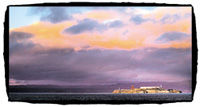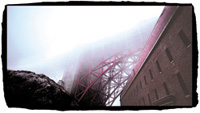Not Just Another Walk In The Park
Vincent Versaces Presidio Project
This park had a story that
wanted to be told," says Vincent Versace, Los Angeles celeb photographer
best known for his images of "the beautiful people" of Hollywood. |
|||
The Digital Route |
|||
Versace describes how he used digital techniques to expand the range and depth of his images. "I bracketed multiple exposures and all of the work was shot using a tripod. I would bracket upward of eight stops in either direction and do that with both shutter speed and aperture so I could get the desired depth of field and the exposure I wanted. Whatever the shot was, I could expose the foreground, mid ground, and background, then pick the best examples out of the exposures and pin register. I have shots that have over 11 stops of dynamic range in them and people can't figure out how I do that. I was at a large format conference and shooting digital and all these guys shoot 4x5, so they were gunning for me. I pull out this photograph of fog which is a composite of 11 shots of the same thing and they all take a gasp and then ask--`Well, okay, how did you do it?'" |
|||
In short, Versace's technique uses what he calls real, exposed pixels to create the reality instead of manipulated pixels in Photoshop. "I use Photoshop as an emery board rather than a jackhammer," he says. "One of the interesting things I found when using Photoshop is that the `red-headed stepchildren' (the unwanted tools) in the graphics world are usually the eraser and the magic wand, sometimes called `the tragic wand,' but these are two of the tools I use the most. Keep in mind that every time you do something in Photoshop you dump information and that creates artifacts, which are cumulative. If you do too much of it you will be able to look at a photograph and say, oh, that's digital. Like grain is an artifact of film, digital has its own set of artifacts. |
|||
"Blowing pictures up
as large as 24x30, as I did for this project, forced me to come up with
a way to work these highly manipulated images, to get the feel and look
I saw. I also work in RAW file format because I don't want the compression
to occur. I want a relatively small file but still want to have the best
possible data. JPEG is great in an emergency situation. One of the mistakes
people make with digital is that they never expected their film camera
to do the processing, but people expect that of their digital camera.
The minute you go to JPEG, that is what happens." |
|||
Digital Expectations |






































